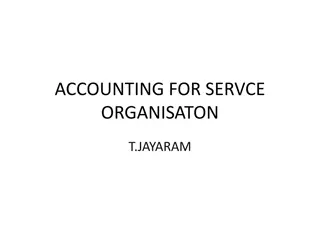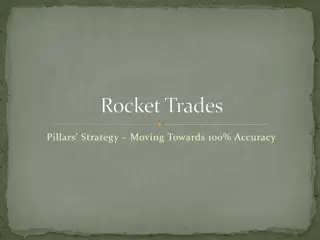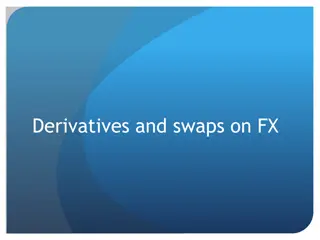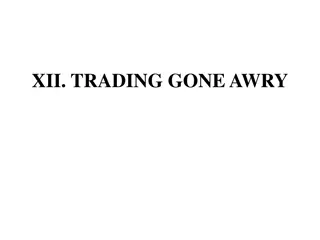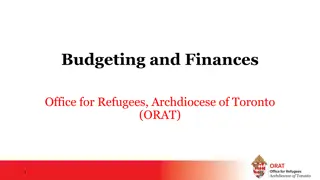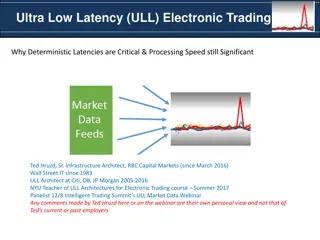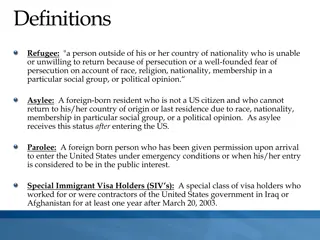Understanding Futures and Daily Resettlement in Financial Trading
Explore the concepts of derivatives, futures contracts, and daily resettlement in financial markets. Learn about the differences between forward and futures contracts, standardizing features, and examples of daily resettlement with FX trading. Gain insights into how investors navigate risks and opportunities in the world of futures trading.
Download Presentation

Please find below an Image/Link to download the presentation.
The content on the website is provided AS IS for your information and personal use only. It may not be sold, licensed, or shared on other websites without obtaining consent from the author. Download presentation by click this link. If you encounter any issues during the download, it is possible that the publisher has removed the file from their server.
E N D
Presentation Transcript
We all chase money because we are afraid to chase dreams Andres Ramirez Ph.D.
A Forward contract An agreement between two parties to buy or sell an asset at a future date at a price defined today. Gentleman s agreement Book, car, a favor, anything, even a job Buyer long Seller short
Users of forwards Importers Exporters Farmers Millers, Food processors Energy plants, big users
Futures Contracts: Preliminaries A futures contract is like a forward contract: It specifies that a certain currency (or other asset) will be exchanged for another at a specified time in the future at prices specified today. A futures contract is different from a forward contract: Futures are standardized contracts trading on organized exchanges with daily resettlement through a clearinghouse.
Futures Contracts: Preliminaries Standardizing Features: Contract Size Delivery Month Daily resettlement Initial performance bond (about 2 percent of contract value, cash or T-bills held in a street name at your brokerage).
Daily Resettlement: An Example Using FX Consider a long position in the CME Euro/U.S. Dollar contract. It is written on 125,000 and quoted in $ per . The strike price is $1.30 the maturity is 3 months. At initiation of the contract, the long posts an initial performance bond of $6,500. The maintenance performance bond is $4,000.
Daily Resettlement: An Example Recall that an investor with a long position gains from increases in the price of the underlying asset. Our investor has agreed to BUY 125,000 at $1.30 per euro in three months time. With a forward contract, at the end of three months, if the euro was worth $1.24, he would lose $7,500 = ($1.24 $1.30) 125,000. If instead at maturity the euro was worth $1.35, the counterparty to his forward contract would pay him $6,250 = ($1.35 $1.30) 125,000.
Daily Resettlement: An Example With futures, we have daily resettlement of gains an losses rather than one big settlement at maturity. Every trading day: if the price goes down, the long pays the short if the price goes up, the short pays the long After the daily resettlement, each party has a new contract at the new price with one-day- shorter maturity.
Performance Bond Money Each day s losses are subtracted from the investor s account. Each day s gains are added to the account. In this example, at initiation the long posts an initial performance bond of $6,500. The maintenance level is $4,000. If this investor loses more than $2,500 he has a decision to make: he can maintain his long position only by adding more funds if he fails to do so, his position will be closed out with an offsetting short position. 7-10
Daily Resettlement: An Example Over the first 3 days, the euro strengthens then depreciates in dollar terms: Settle Gain/Loss Account Balance $1.31 $1.30 $1.27 On third day suppose our investor keeps his long position open by posting an additional $3,750. $1,250 $1,250 $3,750 = ($1.31 $1.30) 125,000 $6,500 $2,750 $7,750 = $6,500 + $1,250 + $3,750 = $6,500 7-11
Daily Resettlement: An Example Over the next 2 days, the long keeps losing money and closes out his position at the end of day five. Settle Gain/Loss Account Balance $1.31 $1.30 $1.27 $1.26 $1.24 $1,250 $1,250 $3,750 $1,250 $2,500 $7,750 $6,500 $2,750 + $3,750 = $6,500 $5,250 $2,750 = $6,500 $1,250 7-12
Toting Up At the end of his adventures, our investor has three ways of computing his gains and losses: Sum of daily gains and losses $7,500 = $1,250 $1,250 $3,750 $1,250 $2,500 Contract size times the difference between initial contract price and last settlement price. $7,500 = ($1.24/ $1.30/ ) 125,000 Ending balance on account minus beginning balance on account, adjusted for deposits or withdrawals. $7,500 = $2,750 ($6,500 + $3,750) 7-13
Chicago Mercantile Exchange Chicago Mercantile Exchange
Chicago Mercantile Exchange Chicago Mercantile Exchange Groupwork Assume you think that the S&P is going to go up. In fact you think it is going to get to 3,000 by March 21st. You look at the quotes on CME and see that ESH2008 is trading at 2783 You buy 10 Contracts How much money will you have to put down? How much would be your gains if SP500 goes to 3,000? How much would you lose if it goes to 2,500?


![Guardians of Collection Enhancing Your Trading Card Experience with the Explorer Sleeve Bundle [4-pack]](/thumb/3698/guardians-of-collection-enhancing-your-trading-card-experience-with-the-explorer-sleeve-bundle-4-pack.jpg)






